Business Research: Alcohol Marketing and Youth Consumption (RES800)
VerifiedAdded on 2022/09/11
|9
|2838
|18
Report
AI Summary
This report provides a comprehensive literature review on the impact of alcohol marketing on underage youth consumption in the United States. The report examines various marketing strategies employed by the alcohol industry, including sponsorships, attractive advertisement campaigns, and promotions, and their effectiveness in targeting the youth demographic. It explores the role of social media and product placement in influencing consumption behavior. The research objectives include identifying these marketing strategies, evaluating ethical and social responsibility issues, and analyzing methods to control underage alcohol consumption. The study employs a quantitative approach, utilizing primary data collected through online surveys with underage youth. The methodology is based on positivism philosophy, with data analyzed using quantitative methods and a Likert scale. The report also discusses the application of STP (Segmentation, Targeting, and Positioning) and the theory of planned behavior in understanding and controlling underage drinking, concluding with ethical considerations and data protection measures. The report's findings highlight the significant influence of marketing on youth drinking patterns and proposes strategies for industry and regulatory bodies to mitigate the negative consequences of underage alcohol consumption.
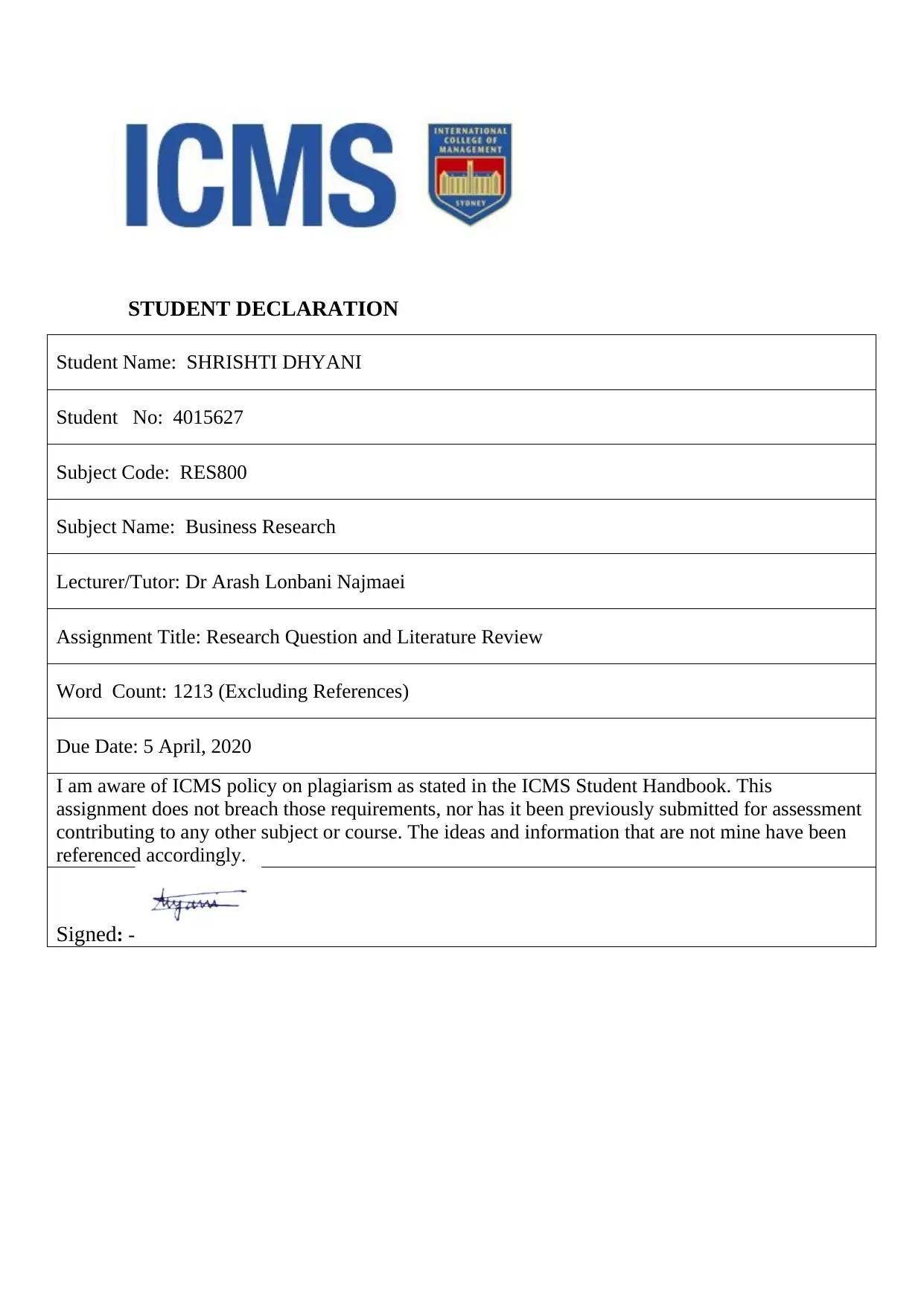
STUDENT DECLARATION
Student Name: SHRISHTI DHYANI
Student No: 4015627
Subject Code: RES800
Subject Name: Business Research
Lecturer/Tutor: Dr Arash Lonbani Najmaei
Assignment Title: Research Question and Literature Review
Word Count: 1213 (Excluding References)
Due Date: 5 April, 2020
I am aware of ICMS policy on plagiarism as stated in the ICMS Student Handbook. This
assignment does not breach those requirements, nor has it been previously submitted for assessment
contributing to any other subject or course. The ideas and information that are not mine have been
referenced accordingly.
Signed: -
Student Name: SHRISHTI DHYANI
Student No: 4015627
Subject Code: RES800
Subject Name: Business Research
Lecturer/Tutor: Dr Arash Lonbani Najmaei
Assignment Title: Research Question and Literature Review
Word Count: 1213 (Excluding References)
Due Date: 5 April, 2020
I am aware of ICMS policy on plagiarism as stated in the ICMS Student Handbook. This
assignment does not breach those requirements, nor has it been previously submitted for assessment
contributing to any other subject or course. The ideas and information that are not mine have been
referenced accordingly.
Signed: -
Paraphrase This Document
Need a fresh take? Get an instant paraphrase of this document with our AI Paraphraser
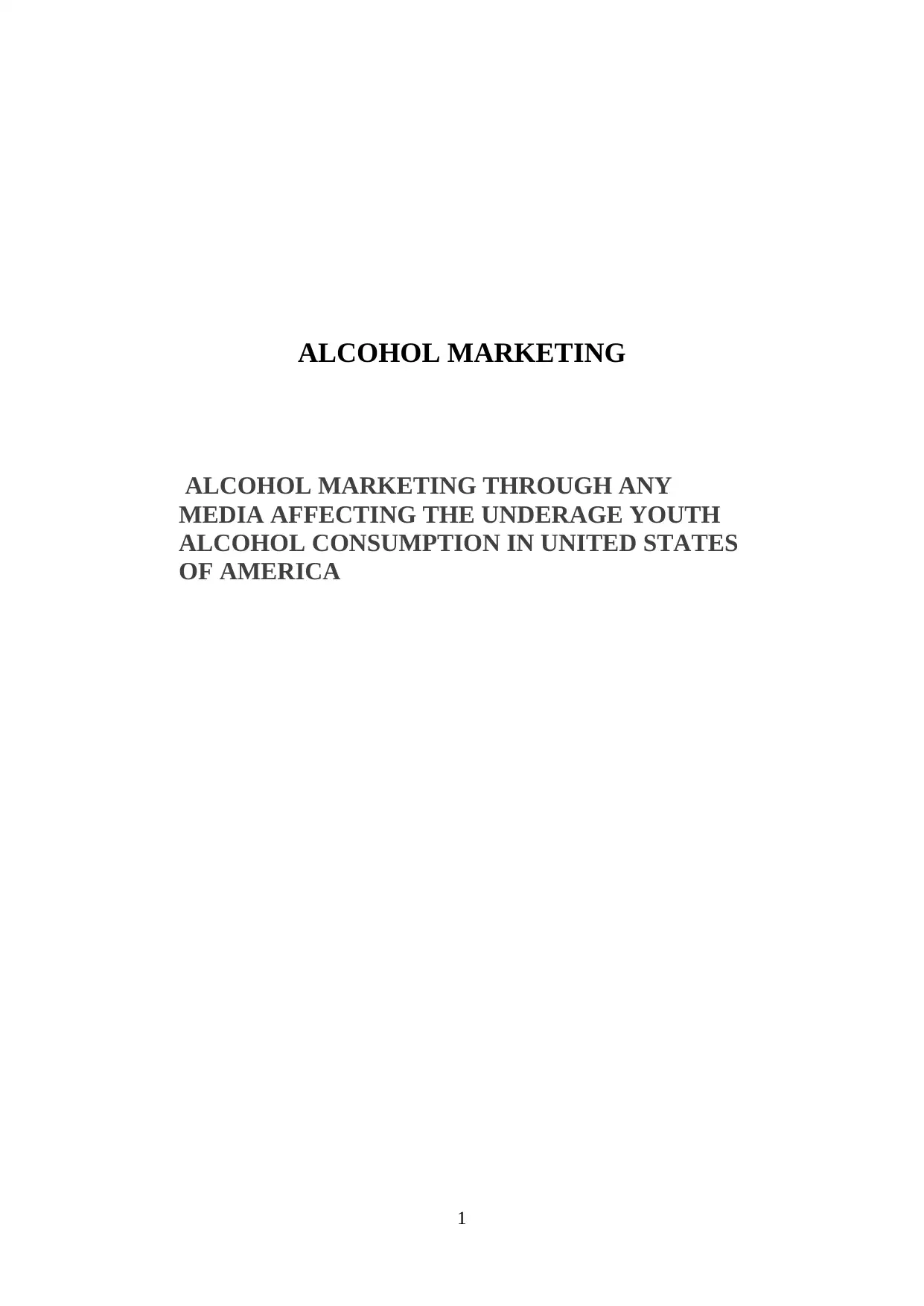
ALCOHOL MARKETING
ALCOHOL MARKETING THROUGH ANY
MEDIA AFFECTING THE UNDERAGE YOUTH
ALCOHOL CONSUMPTION IN UNITED STATES
OF AMERICA
1
ALCOHOL MARKETING THROUGH ANY
MEDIA AFFECTING THE UNDERAGE YOUTH
ALCOHOL CONSUMPTION IN UNITED STATES
OF AMERICA
1
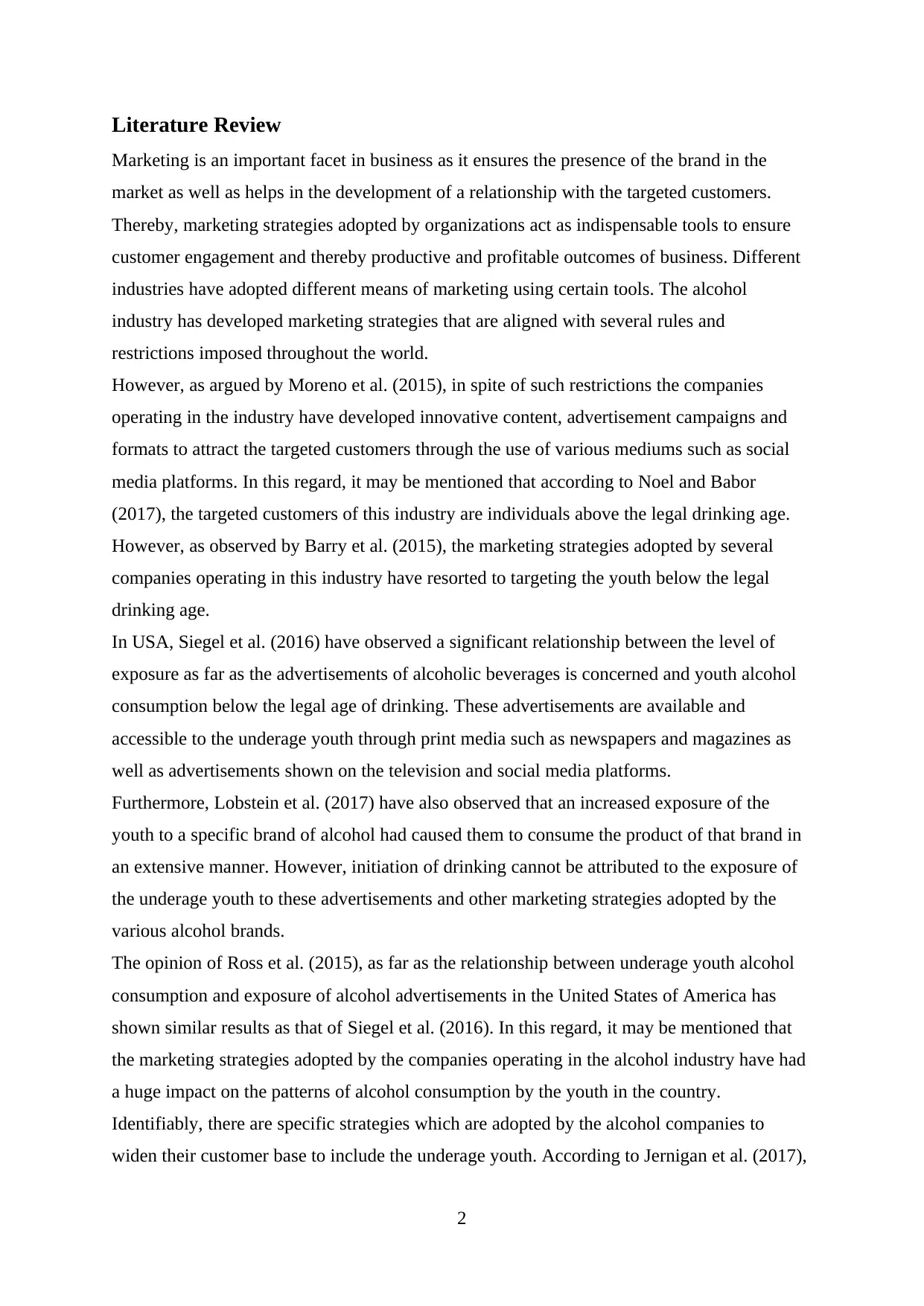
Literature Review
Marketing is an important facet in business as it ensures the presence of the brand in the
market as well as helps in the development of a relationship with the targeted customers.
Thereby, marketing strategies adopted by organizations act as indispensable tools to ensure
customer engagement and thereby productive and profitable outcomes of business. Different
industries have adopted different means of marketing using certain tools. The alcohol
industry has developed marketing strategies that are aligned with several rules and
restrictions imposed throughout the world.
However, as argued by Moreno et al. (2015), in spite of such restrictions the companies
operating in the industry have developed innovative content, advertisement campaigns and
formats to attract the targeted customers through the use of various mediums such as social
media platforms. In this regard, it may be mentioned that according to Noel and Babor
(2017), the targeted customers of this industry are individuals above the legal drinking age.
However, as observed by Barry et al. (2015), the marketing strategies adopted by several
companies operating in this industry have resorted to targeting the youth below the legal
drinking age.
In USA, Siegel et al. (2016) have observed a significant relationship between the level of
exposure as far as the advertisements of alcoholic beverages is concerned and youth alcohol
consumption below the legal age of drinking. These advertisements are available and
accessible to the underage youth through print media such as newspapers and magazines as
well as advertisements shown on the television and social media platforms.
Furthermore, Lobstein et al. (2017) have also observed that an increased exposure of the
youth to a specific brand of alcohol had caused them to consume the product of that brand in
an extensive manner. However, initiation of drinking cannot be attributed to the exposure of
the underage youth to these advertisements and other marketing strategies adopted by the
various alcohol brands.
The opinion of Ross et al. (2015), as far as the relationship between underage youth alcohol
consumption and exposure of alcohol advertisements in the United States of America has
shown similar results as that of Siegel et al. (2016). In this regard, it may be mentioned that
the marketing strategies adopted by the companies operating in the alcohol industry have had
a huge impact on the patterns of alcohol consumption by the youth in the country.
Identifiably, there are specific strategies which are adopted by the alcohol companies to
widen their customer base to include the underage youth. According to Jernigan et al. (2017),
2
Marketing is an important facet in business as it ensures the presence of the brand in the
market as well as helps in the development of a relationship with the targeted customers.
Thereby, marketing strategies adopted by organizations act as indispensable tools to ensure
customer engagement and thereby productive and profitable outcomes of business. Different
industries have adopted different means of marketing using certain tools. The alcohol
industry has developed marketing strategies that are aligned with several rules and
restrictions imposed throughout the world.
However, as argued by Moreno et al. (2015), in spite of such restrictions the companies
operating in the industry have developed innovative content, advertisement campaigns and
formats to attract the targeted customers through the use of various mediums such as social
media platforms. In this regard, it may be mentioned that according to Noel and Babor
(2017), the targeted customers of this industry are individuals above the legal drinking age.
However, as observed by Barry et al. (2015), the marketing strategies adopted by several
companies operating in this industry have resorted to targeting the youth below the legal
drinking age.
In USA, Siegel et al. (2016) have observed a significant relationship between the level of
exposure as far as the advertisements of alcoholic beverages is concerned and youth alcohol
consumption below the legal age of drinking. These advertisements are available and
accessible to the underage youth through print media such as newspapers and magazines as
well as advertisements shown on the television and social media platforms.
Furthermore, Lobstein et al. (2017) have also observed that an increased exposure of the
youth to a specific brand of alcohol had caused them to consume the product of that brand in
an extensive manner. However, initiation of drinking cannot be attributed to the exposure of
the underage youth to these advertisements and other marketing strategies adopted by the
various alcohol brands.
The opinion of Ross et al. (2015), as far as the relationship between underage youth alcohol
consumption and exposure of alcohol advertisements in the United States of America has
shown similar results as that of Siegel et al. (2016). In this regard, it may be mentioned that
the marketing strategies adopted by the companies operating in the alcohol industry have had
a huge impact on the patterns of alcohol consumption by the youth in the country.
Identifiably, there are specific strategies which are adopted by the alcohol companies to
widen their customer base to include the underage youth. According to Jernigan et al. (2017),
2
⊘ This is a preview!⊘
Do you want full access?
Subscribe today to unlock all pages.

Trusted by 1+ million students worldwide
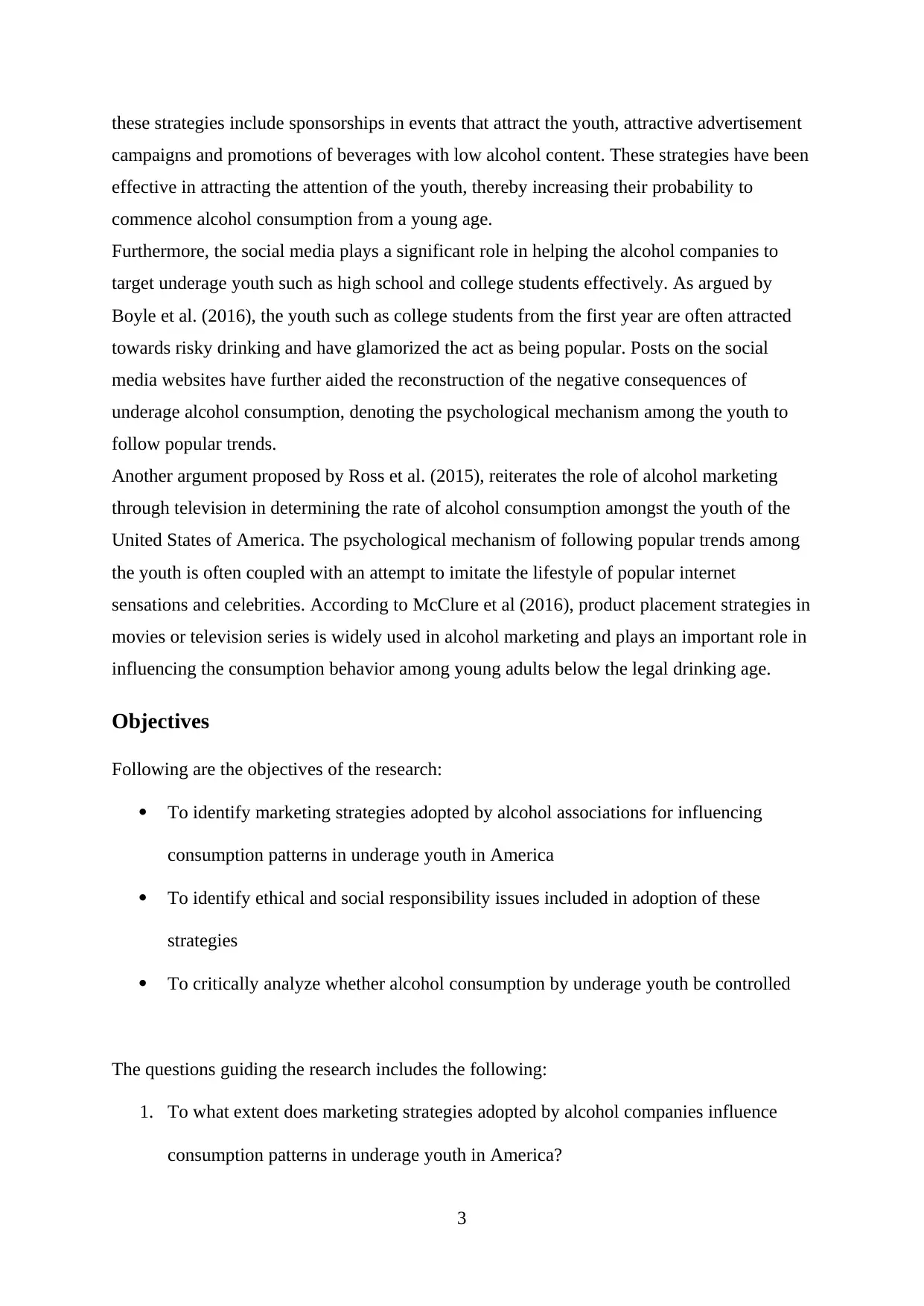
these strategies include sponsorships in events that attract the youth, attractive advertisement
campaigns and promotions of beverages with low alcohol content. These strategies have been
effective in attracting the attention of the youth, thereby increasing their probability to
commence alcohol consumption from a young age.
Furthermore, the social media plays a significant role in helping the alcohol companies to
target underage youth such as high school and college students effectively. As argued by
Boyle et al. (2016), the youth such as college students from the first year are often attracted
towards risky drinking and have glamorized the act as being popular. Posts on the social
media websites have further aided the reconstruction of the negative consequences of
underage alcohol consumption, denoting the psychological mechanism among the youth to
follow popular trends.
Another argument proposed by Ross et al. (2015), reiterates the role of alcohol marketing
through television in determining the rate of alcohol consumption amongst the youth of the
United States of America. The psychological mechanism of following popular trends among
the youth is often coupled with an attempt to imitate the lifestyle of popular internet
sensations and celebrities. According to McClure et al (2016), product placement strategies in
movies or television series is widely used in alcohol marketing and plays an important role in
influencing the consumption behavior among young adults below the legal drinking age.
Objectives
Following are the objectives of the research:
To identify marketing strategies adopted by alcohol associations for influencing
consumption patterns in underage youth in America
To identify ethical and social responsibility issues included in adoption of these
strategies
To critically analyze whether alcohol consumption by underage youth be controlled
The questions guiding the research includes the following:
1. To what extent does marketing strategies adopted by alcohol companies influence
consumption patterns in underage youth in America?
3
campaigns and promotions of beverages with low alcohol content. These strategies have been
effective in attracting the attention of the youth, thereby increasing their probability to
commence alcohol consumption from a young age.
Furthermore, the social media plays a significant role in helping the alcohol companies to
target underage youth such as high school and college students effectively. As argued by
Boyle et al. (2016), the youth such as college students from the first year are often attracted
towards risky drinking and have glamorized the act as being popular. Posts on the social
media websites have further aided the reconstruction of the negative consequences of
underage alcohol consumption, denoting the psychological mechanism among the youth to
follow popular trends.
Another argument proposed by Ross et al. (2015), reiterates the role of alcohol marketing
through television in determining the rate of alcohol consumption amongst the youth of the
United States of America. The psychological mechanism of following popular trends among
the youth is often coupled with an attempt to imitate the lifestyle of popular internet
sensations and celebrities. According to McClure et al (2016), product placement strategies in
movies or television series is widely used in alcohol marketing and plays an important role in
influencing the consumption behavior among young adults below the legal drinking age.
Objectives
Following are the objectives of the research:
To identify marketing strategies adopted by alcohol associations for influencing
consumption patterns in underage youth in America
To identify ethical and social responsibility issues included in adoption of these
strategies
To critically analyze whether alcohol consumption by underage youth be controlled
The questions guiding the research includes the following:
1. To what extent does marketing strategies adopted by alcohol companies influence
consumption patterns in underage youth in America?
3
Paraphrase This Document
Need a fresh take? Get an instant paraphrase of this document with our AI Paraphraser
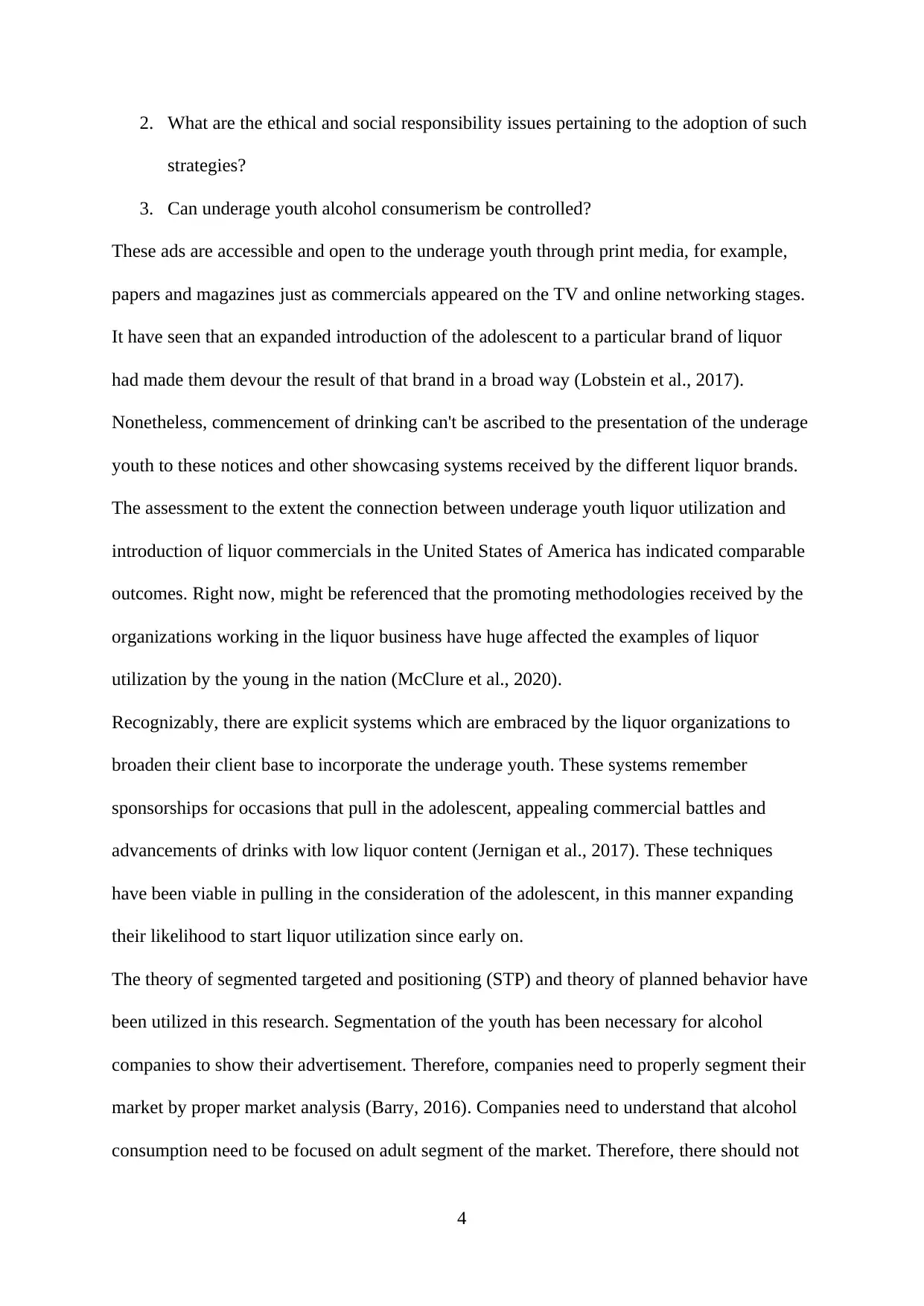
2. What are the ethical and social responsibility issues pertaining to the adoption of such
strategies?
3. Can underage youth alcohol consumerism be controlled?
These ads are accessible and open to the underage youth through print media, for example,
papers and magazines just as commercials appeared on the TV and online networking stages.
It have seen that an expanded introduction of the adolescent to a particular brand of liquor
had made them devour the result of that brand in a broad way (Lobstein et al., 2017).
Nonetheless, commencement of drinking can't be ascribed to the presentation of the underage
youth to these notices and other showcasing systems received by the different liquor brands.
The assessment to the extent the connection between underage youth liquor utilization and
introduction of liquor commercials in the United States of America has indicated comparable
outcomes. Right now, might be referenced that the promoting methodologies received by the
organizations working in the liquor business have huge affected the examples of liquor
utilization by the young in the nation (McClure et al., 2020).
Recognizably, there are explicit systems which are embraced by the liquor organizations to
broaden their client base to incorporate the underage youth. These systems remember
sponsorships for occasions that pull in the adolescent, appealing commercial battles and
advancements of drinks with low liquor content (Jernigan et al., 2017). These techniques
have been viable in pulling in the consideration of the adolescent, in this manner expanding
their likelihood to start liquor utilization since early on.
The theory of segmented targeted and positioning (STP) and theory of planned behavior have
been utilized in this research. Segmentation of the youth has been necessary for alcohol
companies to show their advertisement. Therefore, companies need to properly segment their
market by proper market analysis (Barry, 2016). Companies need to understand that alcohol
consumption need to be focused on adult segment of the market. Therefore, there should not
4
strategies?
3. Can underage youth alcohol consumerism be controlled?
These ads are accessible and open to the underage youth through print media, for example,
papers and magazines just as commercials appeared on the TV and online networking stages.
It have seen that an expanded introduction of the adolescent to a particular brand of liquor
had made them devour the result of that brand in a broad way (Lobstein et al., 2017).
Nonetheless, commencement of drinking can't be ascribed to the presentation of the underage
youth to these notices and other showcasing systems received by the different liquor brands.
The assessment to the extent the connection between underage youth liquor utilization and
introduction of liquor commercials in the United States of America has indicated comparable
outcomes. Right now, might be referenced that the promoting methodologies received by the
organizations working in the liquor business have huge affected the examples of liquor
utilization by the young in the nation (McClure et al., 2020).
Recognizably, there are explicit systems which are embraced by the liquor organizations to
broaden their client base to incorporate the underage youth. These systems remember
sponsorships for occasions that pull in the adolescent, appealing commercial battles and
advancements of drinks with low liquor content (Jernigan et al., 2017). These techniques
have been viable in pulling in the consideration of the adolescent, in this manner expanding
their likelihood to start liquor utilization since early on.
The theory of segmented targeted and positioning (STP) and theory of planned behavior have
been utilized in this research. Segmentation of the youth has been necessary for alcohol
companies to show their advertisement. Therefore, companies need to properly segment their
market by proper market analysis (Barry, 2016). Companies need to understand that alcohol
consumption need to be focused on adult segment of the market. Therefore, there should not
4
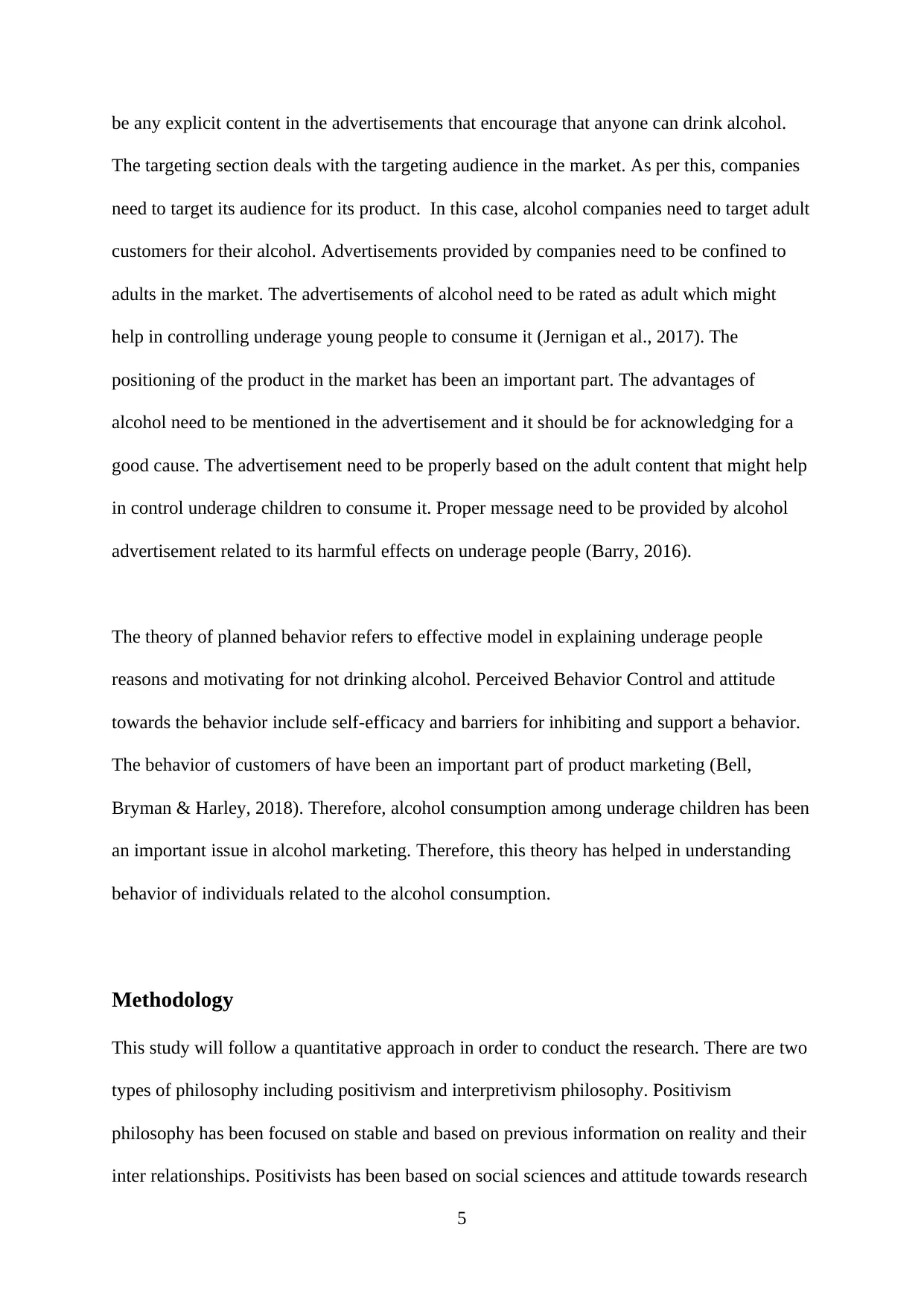
be any explicit content in the advertisements that encourage that anyone can drink alcohol.
The targeting section deals with the targeting audience in the market. As per this, companies
need to target its audience for its product. In this case, alcohol companies need to target adult
customers for their alcohol. Advertisements provided by companies need to be confined to
adults in the market. The advertisements of alcohol need to be rated as adult which might
help in controlling underage young people to consume it (Jernigan et al., 2017). The
positioning of the product in the market has been an important part. The advantages of
alcohol need to be mentioned in the advertisement and it should be for acknowledging for a
good cause. The advertisement need to be properly based on the adult content that might help
in control underage children to consume it. Proper message need to be provided by alcohol
advertisement related to its harmful effects on underage people (Barry, 2016).
The theory of planned behavior refers to effective model in explaining underage people
reasons and motivating for not drinking alcohol. Perceived Behavior Control and attitude
towards the behavior include self-efficacy and barriers for inhibiting and support a behavior.
The behavior of customers of have been an important part of product marketing (Bell,
Bryman & Harley, 2018). Therefore, alcohol consumption among underage children has been
an important issue in alcohol marketing. Therefore, this theory has helped in understanding
behavior of individuals related to the alcohol consumption.
Methodology
This study will follow a quantitative approach in order to conduct the research. There are two
types of philosophy including positivism and interpretivism philosophy. Positivism
philosophy has been focused on stable and based on previous information on reality and their
inter relationships. Positivists has been based on social sciences and attitude towards research
5
The targeting section deals with the targeting audience in the market. As per this, companies
need to target its audience for its product. In this case, alcohol companies need to target adult
customers for their alcohol. Advertisements provided by companies need to be confined to
adults in the market. The advertisements of alcohol need to be rated as adult which might
help in controlling underage young people to consume it (Jernigan et al., 2017). The
positioning of the product in the market has been an important part. The advantages of
alcohol need to be mentioned in the advertisement and it should be for acknowledging for a
good cause. The advertisement need to be properly based on the adult content that might help
in control underage children to consume it. Proper message need to be provided by alcohol
advertisement related to its harmful effects on underage people (Barry, 2016).
The theory of planned behavior refers to effective model in explaining underage people
reasons and motivating for not drinking alcohol. Perceived Behavior Control and attitude
towards the behavior include self-efficacy and barriers for inhibiting and support a behavior.
The behavior of customers of have been an important part of product marketing (Bell,
Bryman & Harley, 2018). Therefore, alcohol consumption among underage children has been
an important issue in alcohol marketing. Therefore, this theory has helped in understanding
behavior of individuals related to the alcohol consumption.
Methodology
This study will follow a quantitative approach in order to conduct the research. There are two
types of philosophy including positivism and interpretivism philosophy. Positivism
philosophy has been focused on stable and based on previous information on reality and their
inter relationships. Positivists has been based on social sciences and attitude towards research
5
⊘ This is a preview!⊘
Do you want full access?
Subscribe today to unlock all pages.

Trusted by 1+ million students worldwide
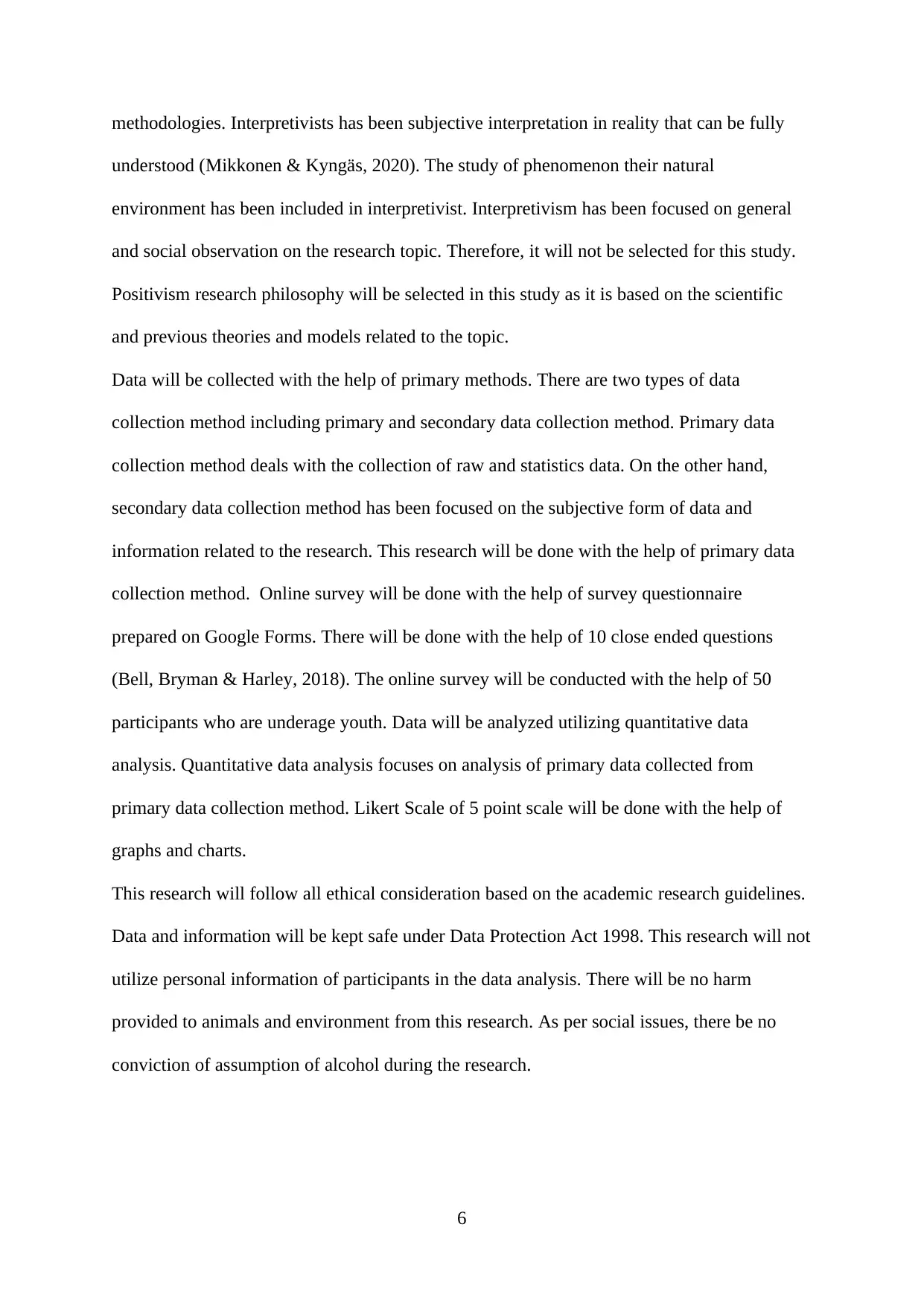
methodologies. Interpretivists has been subjective interpretation in reality that can be fully
understood (Mikkonen & Kyngäs, 2020). The study of phenomenon their natural
environment has been included in interpretivist. Interpretivism has been focused on general
and social observation on the research topic. Therefore, it will not be selected for this study.
Positivism research philosophy will be selected in this study as it is based on the scientific
and previous theories and models related to the topic.
Data will be collected with the help of primary methods. There are two types of data
collection method including primary and secondary data collection method. Primary data
collection method deals with the collection of raw and statistics data. On the other hand,
secondary data collection method has been focused on the subjective form of data and
information related to the research. This research will be done with the help of primary data
collection method. Online survey will be done with the help of survey questionnaire
prepared on Google Forms. There will be done with the help of 10 close ended questions
(Bell, Bryman & Harley, 2018). The online survey will be conducted with the help of 50
participants who are underage youth. Data will be analyzed utilizing quantitative data
analysis. Quantitative data analysis focuses on analysis of primary data collected from
primary data collection method. Likert Scale of 5 point scale will be done with the help of
graphs and charts.
This research will follow all ethical consideration based on the academic research guidelines.
Data and information will be kept safe under Data Protection Act 1998. This research will not
utilize personal information of participants in the data analysis. There will be no harm
provided to animals and environment from this research. As per social issues, there be no
conviction of assumption of alcohol during the research.
6
understood (Mikkonen & Kyngäs, 2020). The study of phenomenon their natural
environment has been included in interpretivist. Interpretivism has been focused on general
and social observation on the research topic. Therefore, it will not be selected for this study.
Positivism research philosophy will be selected in this study as it is based on the scientific
and previous theories and models related to the topic.
Data will be collected with the help of primary methods. There are two types of data
collection method including primary and secondary data collection method. Primary data
collection method deals with the collection of raw and statistics data. On the other hand,
secondary data collection method has been focused on the subjective form of data and
information related to the research. This research will be done with the help of primary data
collection method. Online survey will be done with the help of survey questionnaire
prepared on Google Forms. There will be done with the help of 10 close ended questions
(Bell, Bryman & Harley, 2018). The online survey will be conducted with the help of 50
participants who are underage youth. Data will be analyzed utilizing quantitative data
analysis. Quantitative data analysis focuses on analysis of primary data collected from
primary data collection method. Likert Scale of 5 point scale will be done with the help of
graphs and charts.
This research will follow all ethical consideration based on the academic research guidelines.
Data and information will be kept safe under Data Protection Act 1998. This research will not
utilize personal information of participants in the data analysis. There will be no harm
provided to animals and environment from this research. As per social issues, there be no
conviction of assumption of alcohol during the research.
6
Paraphrase This Document
Need a fresh take? Get an instant paraphrase of this document with our AI Paraphraser
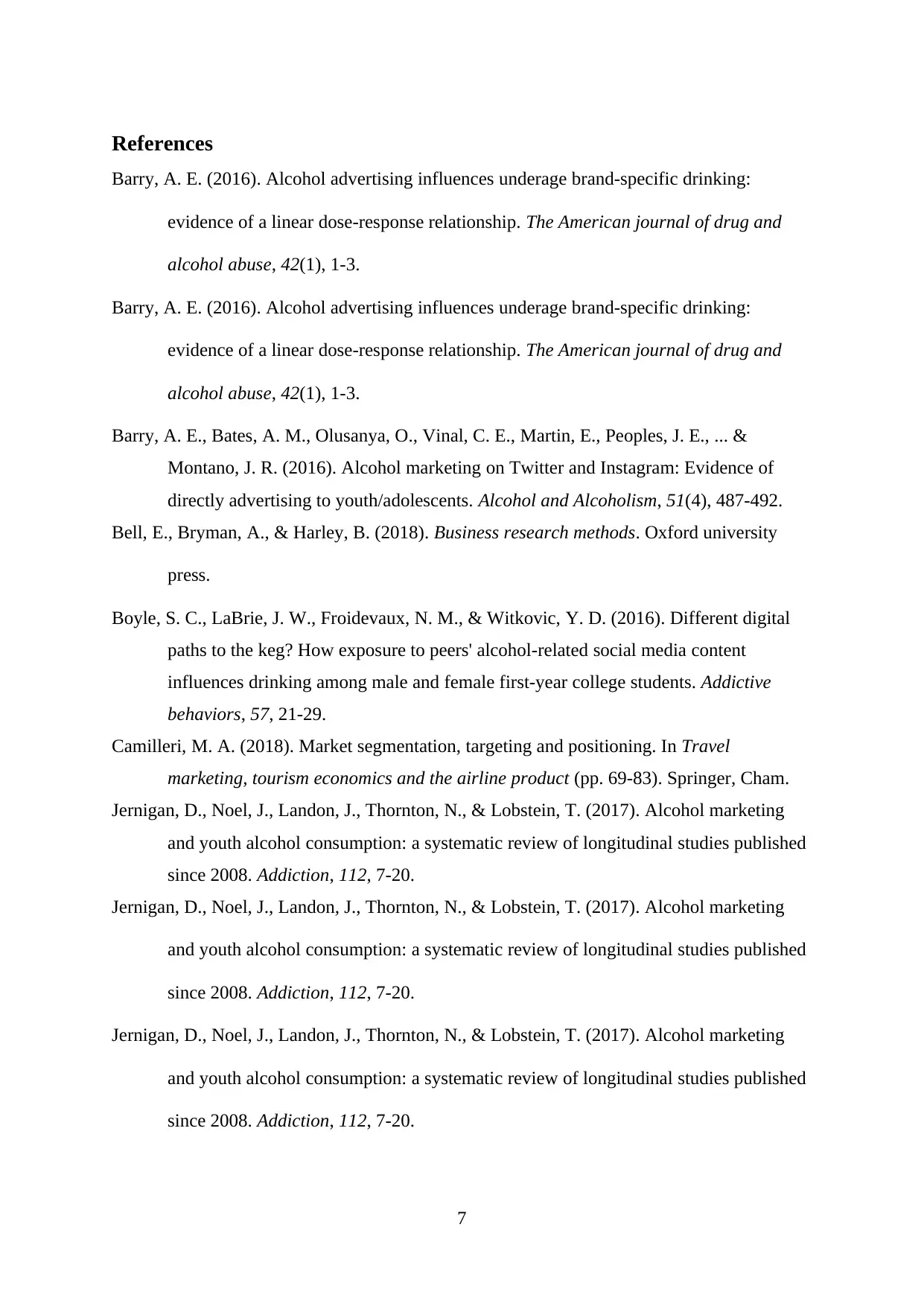
References
Barry, A. E. (2016). Alcohol advertising influences underage brand-specific drinking:
evidence of a linear dose-response relationship. The American journal of drug and
alcohol abuse, 42(1), 1-3.
Barry, A. E. (2016). Alcohol advertising influences underage brand-specific drinking:
evidence of a linear dose-response relationship. The American journal of drug and
alcohol abuse, 42(1), 1-3.
Barry, A. E., Bates, A. M., Olusanya, O., Vinal, C. E., Martin, E., Peoples, J. E., ... &
Montano, J. R. (2016). Alcohol marketing on Twitter and Instagram: Evidence of
directly advertising to youth/adolescents. Alcohol and Alcoholism, 51(4), 487-492.
Bell, E., Bryman, A., & Harley, B. (2018). Business research methods. Oxford university
press.
Boyle, S. C., LaBrie, J. W., Froidevaux, N. M., & Witkovic, Y. D. (2016). Different digital
paths to the keg? How exposure to peers' alcohol-related social media content
influences drinking among male and female first-year college students. Addictive
behaviors, 57, 21-29.
Camilleri, M. A. (2018). Market segmentation, targeting and positioning. In Travel
marketing, tourism economics and the airline product (pp. 69-83). Springer, Cham.
Jernigan, D., Noel, J., Landon, J., Thornton, N., & Lobstein, T. (2017). Alcohol marketing
and youth alcohol consumption: a systematic review of longitudinal studies published
since 2008. Addiction, 112, 7-20.
Jernigan, D., Noel, J., Landon, J., Thornton, N., & Lobstein, T. (2017). Alcohol marketing
and youth alcohol consumption: a systematic review of longitudinal studies published
since 2008. Addiction, 112, 7-20.
Jernigan, D., Noel, J., Landon, J., Thornton, N., & Lobstein, T. (2017). Alcohol marketing
and youth alcohol consumption: a systematic review of longitudinal studies published
since 2008. Addiction, 112, 7-20.
7
Barry, A. E. (2016). Alcohol advertising influences underage brand-specific drinking:
evidence of a linear dose-response relationship. The American journal of drug and
alcohol abuse, 42(1), 1-3.
Barry, A. E. (2016). Alcohol advertising influences underage brand-specific drinking:
evidence of a linear dose-response relationship. The American journal of drug and
alcohol abuse, 42(1), 1-3.
Barry, A. E., Bates, A. M., Olusanya, O., Vinal, C. E., Martin, E., Peoples, J. E., ... &
Montano, J. R. (2016). Alcohol marketing on Twitter and Instagram: Evidence of
directly advertising to youth/adolescents. Alcohol and Alcoholism, 51(4), 487-492.
Bell, E., Bryman, A., & Harley, B. (2018). Business research methods. Oxford university
press.
Boyle, S. C., LaBrie, J. W., Froidevaux, N. M., & Witkovic, Y. D. (2016). Different digital
paths to the keg? How exposure to peers' alcohol-related social media content
influences drinking among male and female first-year college students. Addictive
behaviors, 57, 21-29.
Camilleri, M. A. (2018). Market segmentation, targeting and positioning. In Travel
marketing, tourism economics and the airline product (pp. 69-83). Springer, Cham.
Jernigan, D., Noel, J., Landon, J., Thornton, N., & Lobstein, T. (2017). Alcohol marketing
and youth alcohol consumption: a systematic review of longitudinal studies published
since 2008. Addiction, 112, 7-20.
Jernigan, D., Noel, J., Landon, J., Thornton, N., & Lobstein, T. (2017). Alcohol marketing
and youth alcohol consumption: a systematic review of longitudinal studies published
since 2008. Addiction, 112, 7-20.
Jernigan, D., Noel, J., Landon, J., Thornton, N., & Lobstein, T. (2017). Alcohol marketing
and youth alcohol consumption: a systematic review of longitudinal studies published
since 2008. Addiction, 112, 7-20.
7
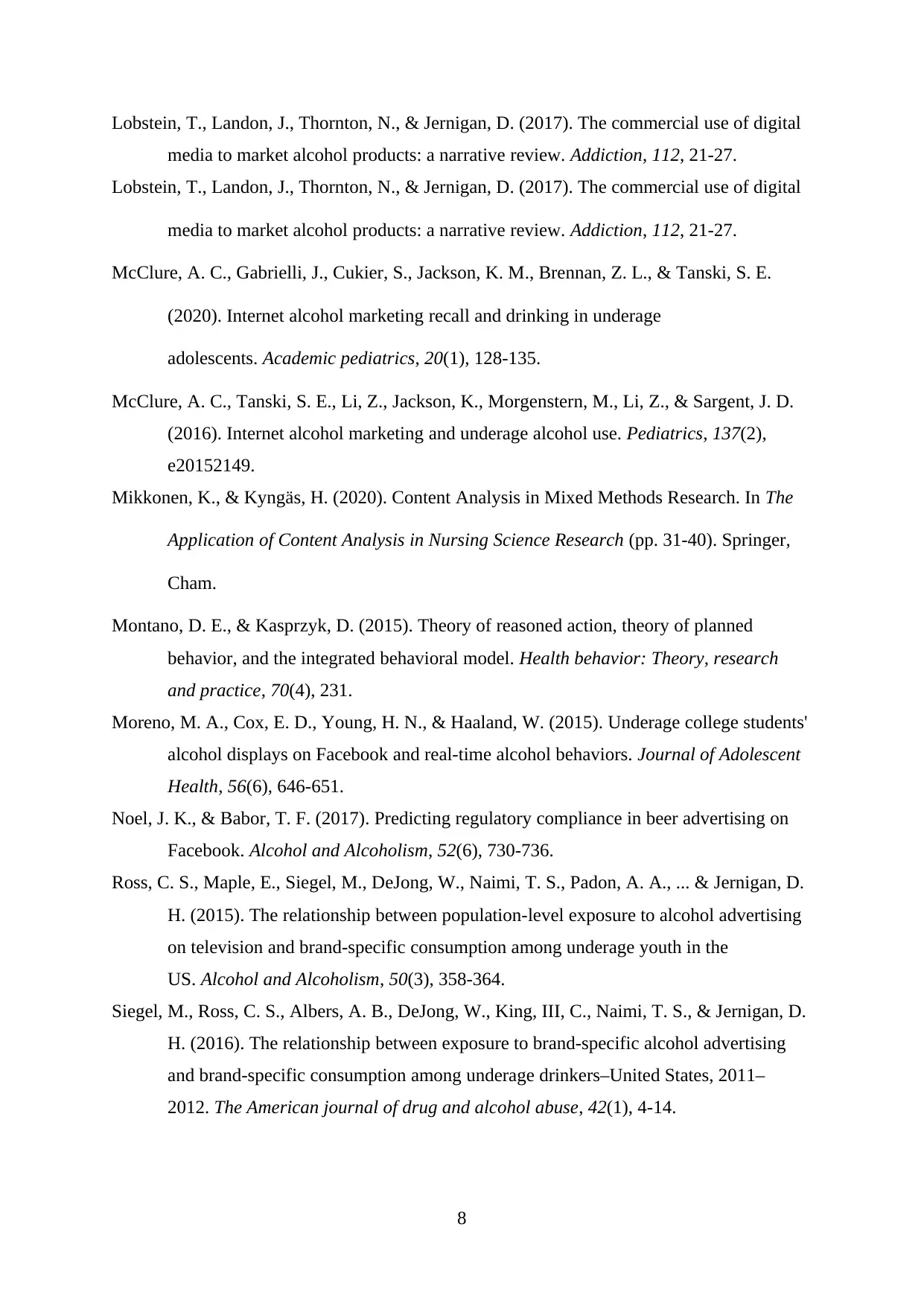
Lobstein, T., Landon, J., Thornton, N., & Jernigan, D. (2017). The commercial use of digital
media to market alcohol products: a narrative review. Addiction, 112, 21-27.
Lobstein, T., Landon, J., Thornton, N., & Jernigan, D. (2017). The commercial use of digital
media to market alcohol products: a narrative review. Addiction, 112, 21-27.
McClure, A. C., Gabrielli, J., Cukier, S., Jackson, K. M., Brennan, Z. L., & Tanski, S. E.
(2020). Internet alcohol marketing recall and drinking in underage
adolescents. Academic pediatrics, 20(1), 128-135.
McClure, A. C., Tanski, S. E., Li, Z., Jackson, K., Morgenstern, M., Li, Z., & Sargent, J. D.
(2016). Internet alcohol marketing and underage alcohol use. Pediatrics, 137(2),
e20152149.
Mikkonen, K., & Kyngäs, H. (2020). Content Analysis in Mixed Methods Research. In The
Application of Content Analysis in Nursing Science Research (pp. 31-40). Springer,
Cham.
Montano, D. E., & Kasprzyk, D. (2015). Theory of reasoned action, theory of planned
behavior, and the integrated behavioral model. Health behavior: Theory, research
and practice, 70(4), 231.
Moreno, M. A., Cox, E. D., Young, H. N., & Haaland, W. (2015). Underage college students'
alcohol displays on Facebook and real-time alcohol behaviors. Journal of Adolescent
Health, 56(6), 646-651.
Noel, J. K., & Babor, T. F. (2017). Predicting regulatory compliance in beer advertising on
Facebook. Alcohol and Alcoholism, 52(6), 730-736.
Ross, C. S., Maple, E., Siegel, M., DeJong, W., Naimi, T. S., Padon, A. A., ... & Jernigan, D.
H. (2015). The relationship between population-level exposure to alcohol advertising
on television and brand-specific consumption among underage youth in the
US. Alcohol and Alcoholism, 50(3), 358-364.
Siegel, M., Ross, C. S., Albers, A. B., DeJong, W., King, III, C., Naimi, T. S., & Jernigan, D.
H. (2016). The relationship between exposure to brand-specific alcohol advertising
and brand-specific consumption among underage drinkers–United States, 2011–
2012. The American journal of drug and alcohol abuse, 42(1), 4-14.
8
media to market alcohol products: a narrative review. Addiction, 112, 21-27.
Lobstein, T., Landon, J., Thornton, N., & Jernigan, D. (2017). The commercial use of digital
media to market alcohol products: a narrative review. Addiction, 112, 21-27.
McClure, A. C., Gabrielli, J., Cukier, S., Jackson, K. M., Brennan, Z. L., & Tanski, S. E.
(2020). Internet alcohol marketing recall and drinking in underage
adolescents. Academic pediatrics, 20(1), 128-135.
McClure, A. C., Tanski, S. E., Li, Z., Jackson, K., Morgenstern, M., Li, Z., & Sargent, J. D.
(2016). Internet alcohol marketing and underage alcohol use. Pediatrics, 137(2),
e20152149.
Mikkonen, K., & Kyngäs, H. (2020). Content Analysis in Mixed Methods Research. In The
Application of Content Analysis in Nursing Science Research (pp. 31-40). Springer,
Cham.
Montano, D. E., & Kasprzyk, D. (2015). Theory of reasoned action, theory of planned
behavior, and the integrated behavioral model. Health behavior: Theory, research
and practice, 70(4), 231.
Moreno, M. A., Cox, E. D., Young, H. N., & Haaland, W. (2015). Underage college students'
alcohol displays on Facebook and real-time alcohol behaviors. Journal of Adolescent
Health, 56(6), 646-651.
Noel, J. K., & Babor, T. F. (2017). Predicting regulatory compliance in beer advertising on
Facebook. Alcohol and Alcoholism, 52(6), 730-736.
Ross, C. S., Maple, E., Siegel, M., DeJong, W., Naimi, T. S., Padon, A. A., ... & Jernigan, D.
H. (2015). The relationship between population-level exposure to alcohol advertising
on television and brand-specific consumption among underage youth in the
US. Alcohol and Alcoholism, 50(3), 358-364.
Siegel, M., Ross, C. S., Albers, A. B., DeJong, W., King, III, C., Naimi, T. S., & Jernigan, D.
H. (2016). The relationship between exposure to brand-specific alcohol advertising
and brand-specific consumption among underage drinkers–United States, 2011–
2012. The American journal of drug and alcohol abuse, 42(1), 4-14.
8
⊘ This is a preview!⊘
Do you want full access?
Subscribe today to unlock all pages.

Trusted by 1+ million students worldwide
1 out of 9
Related Documents
Your All-in-One AI-Powered Toolkit for Academic Success.
+13062052269
info@desklib.com
Available 24*7 on WhatsApp / Email
![[object Object]](/_next/static/media/star-bottom.7253800d.svg)
Unlock your academic potential
Copyright © 2020–2025 A2Z Services. All Rights Reserved. Developed and managed by ZUCOL.





